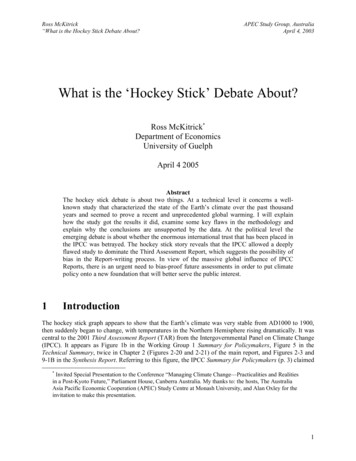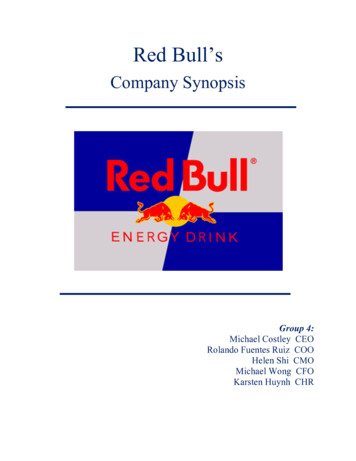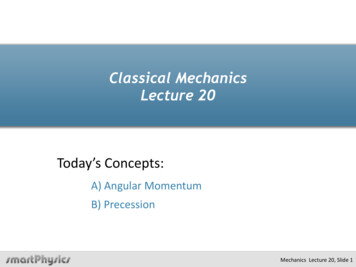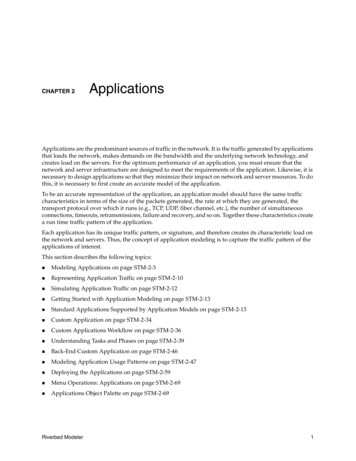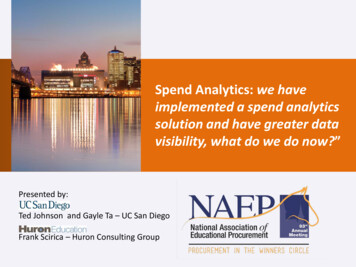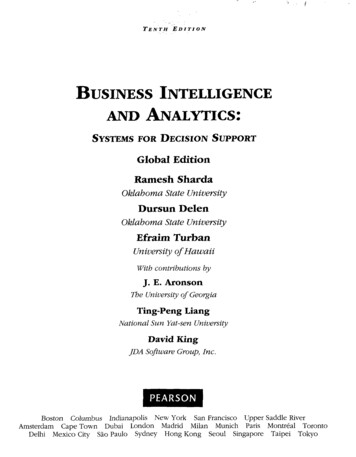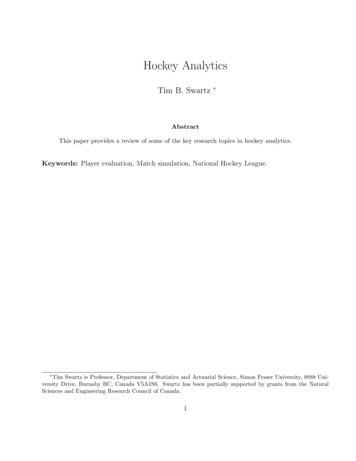
Transcription
Hockey AnalyticsTim B. Swartz AbstractThis paper provides a review of some of the key research topics in hockey analytics.Keywords: Player evaluation, Match simulation, National Hockey League. Tim Swartz is Professor, Department of Statistics and Actuarial Science, Simon Fraser University, 8888 University Drive, Burnaby BC, Canada V5A1S6. Swartz has been partially supported by grants from the NaturalSciences and Engineering Research Council of Canada.1
1INTRODUCTIONThere are various ways of identifying and ranking the “big” sports of the world. For example,participation is an obvious measure (Bialik 2012). Using financial criteria, one may considervariables such as the number of professional teams and leagues, player salaries, ticket prices,television viewership, team valuations, sponsorships, etc. Using financial criteria, there is nodoubt that the six big team sports in the world are soccer, basketball, baseball, American football,hockey and cricket.In the team sports listed above, there is immense pressure to perform at a high level. To helpperform at a high level, analytics have infiltrated the sports world. Analytics problems in sportare vast and include important problems such as player evaluation and scouting, the managementof salaries, player development, modification of tactics, training to improve performance, and thetreatment and prevention of injuries.Clearly, analytics in sport are an expensive business, and team sports have adopted analyticsto various degrees. The sport with the greatest history in analytics is baseball where substantivecontributions were made by Bill James with annual publications of his Baseball Abstract beginningin 1977. Gray (2006) provides a biography of James and his ideas. Baseball is particularly conducive to analytics as it may be described as a “discrete” game where only a countable number ofoutcomes can occur as the result of each pitch. Baseball also has an extensive history of data andrecord keeping which has been beneficial to the growth of baseball analytics. Baseball analyticshas a large following. For example, the Society for American Baseball Research (www.sabr.org)promotes conferences and publications, and boasts a membership of over 6000 individuals interested in the nuances of the sport. It may be argued that baseball analytics (often referred toas sabermetrics) provided the inspiration for other sports to follow suit. The inspiration camethrough the widespread attention provided to the book “Moneyball” (Lewis 2003) which wasdeveloped into the popular 2011 Hollywood movie starring Brad Pitt. Moneyball chronicled the2002 season of the Oakland Athletics, a small-market Major League Baseball team who soughtefficiency gains through the aquisition of undervalued players.In the academic literature, there has been longstanding activity in sports science which isconcerned with topics such as exercise, health, medicine, physiology and psychology. In additionto sports science, there are other academic interests involving sport, and there now exist sportsjournals with a focus on topics such as economics, operations research, engineering and computerscience. On the statistical side, the Journal of Quantitative Analysis in Sports (JQAS) became a2
publication of the American Statistical Association in 2011, and the Journal of Sports Analyticswas founded in 2015. Albert and Bennett (2014) provide a general review of statistics in sports.However, despite the presence of academic journals having a focus on sport, there may be aneven greater activity in industry where the activities and effort have been intentionally suppressed.Many teams in the big sports now have full-time analytics staff where their primary objective isto gain a competitive edge. These personnel are often prevented by their clubs to disclose thenature of their work.Now, where does hockey fit in the above discussion? In terms of publications in peer reviewedjournals, it seems that hockey analytics is middling amongst the big six sports. For example, inthe five-year period 2012-2016, JQAS published 25, 18, 16, 10, 9, and 4 papers on basketball,soccer, American football, hockey, baseball and cricket, respectively. And we note that thenumber of baseball papers may not reflect the actual activity in the sport due to the availabilityof baseball-specific outlets (e.g. Baseball Research Journal).In terms of professional hockey, the National Hockey League (NHL) is the premier hockeyleague in the world consisting of 30 teams and many feeder leagues from Canada and the UnitedStates. The salaries in the NHL are the highest amongst professional leagues with a 73 millionsalary cap in the 2016-2017 season. Other top professional leagues exist in predominantly northernEuropean countries including Sweden, Switzerland, Germany, Czech Republic and Finland. Alongwith Russia, these are also the countries where participation rates are highest and whose nationalteams play at the highest level. McFarlane (1997) provides a history of hockey.In terms of analytics staff in the NHL, the situation in 2010 indicated a general antipathy inhockey towards analytics. However, with the advent of Moneyball, the influence of analytics inother sports and the availability of data, the state of analytics has begun to change in the in-the-nhl/). For example, most NHL teams now have analytics staff. Some teams have evenrecruited academic statisticians to lead these efforts (e.g. Andrew Thomas - Minnesota Wild,Sam Ventura - Pittsburgh Penguins, Brian Macdonald - Florida Panthers).In addition, conferences specializing in hockey analytics are now regular events. These includeEdmonton (2014), Calgary (2014), Pittsburg (2014), Washington (2015), Fort Lauderdale (2016),Rochester (2015, 2016), Vancouver (2016, 2017) and Ottawa (2015, 2016, 2017). There are nowperhaps more conferences than exist hockey research in need of dissemination.This paper attempts to capture the current state of the rapidly changing world of hockeyanalytics. The emphasis is on problems that are more of a complex nature, the types of problems3
that would be attractive to statisticians. There are lots of hockey analytics problems whosesolutions are straightforward. For example, a team may want to know the proportion of faceoffsthat are won by a particular player. As useful as this information may be to teams, we do notconsider straightforward research investigations in this review paper. For a lively discussion ofall types of research problems in hockey (with an emphasis on the non-technical), the book byVollman, Awad and Fyffe (2016) is recommended. In the spirit of Bill James, Vollman has alsoself-published an annual Hockey Abstract beginning in 2013. In Section 2, we describe data thatare available for hockey analytics. This, like everything in hockey analytics is currently in a stateof flux. In Section 3, we describe the Holy Grail of analytics problems, player evaluation. Anumber of approaches have been proposed, and the main techniques are described. The topicof player evaluation is still very much an open area for research as all approaches suffer frommulticollinearity issues. That is, players tend to play with common teammates and it is difficultto separate their respective contributions. In Section 4, the major problem of match simulation isdescribed. The availability of a simulator allows the investigation of various questions of interestin a laboratory setting. The challenge involves the development of a realistic simulator thatcaptures the characteristics of actual hockey games. In Section 5, some miscellaneous topics areexplored. We conclude with a short discussion in Section 6.2DATAIn the early days of the NHL, and today in lower leagues, so-called “statisticians” would attendgames and participate in data entry activities. Depending on the needs of their team, they mightrecord events such as shots, saves, hits, zone entries and the results of face-offs. As the gamemodernized and matches were recorded, statisticians would watch film after the game, and couldproduce even more statistics.Since the 1980’s (Kasan 2008), NHL data has been generated via the NHL’s Real Time ScoringSystem (RTSS). The procedures and the data that have been collected have evolved over the years.Today, at every NHL game, there are a crew of scorers for the home team who view matches andmake decisions in real time. The data are uploaded to nhl.com and can be freely accessed. Thedata include events recorded in a play-by-play format. Although there are uniform standards thathave been imposed on the crews, there has been some criticism over the accuracy of the RTSSdata .Not withstanding the data integrity issues, Thomas and Ventura (2014) have provided a great4
service by making the RTSS data easily accessible. They have created an R package nhlscraprthat provides detailed event information and processing for NHL games. The scraper retrievesplay-by-play game data from the NHL’s RTSS database and stores the data in convenient filesthat can be handled by the R programming language. A typical match includes roughly 400events per game which corresponds to an event roughly every 9 seconds. The nhlscrapr packagecan access NHL matches back to the 2002-2003 regular season.The promise of player-tracking data in the NHL has been a much discussed topic amongstthose involved in hockey analytics. A similar initiative has already taken place in the NationalBasketball Association (NBA) where the SportVU system has been in place since the 2013/2014season. The NBA data has promoted a surge in research activities including previously difficulttopics of investigation such as the evaluation of contributions to defense (Franks, Miller, Bornnand Goldsberry 2015).Although some experimentation has taken place, as of the 2016-2017 season, player-trackinghas not yet been fully implemented in the NHL in the sense that it is not freely available to everyone. Amongst the competing technologies, the company Sportvision has developed an approachthat requires chips in both the puck and in player jerseys. An alternative technology promotedby the company SPORTLOGiQ is based on a single camera in each arena, machine learning andoptical recognition software. There is great detail and accuracy in the SPORTLOGiQ databasewith events occurring every 1.2 seconds on average. The data also records the x and y coordinatesfor every player on the ice for each event and every frame; this is the player-tracking aspect ofthe data.Similar to the NBA, we expect a surge of research activity in hockey analytics once playertracking data becomes widely available. With massive datasets expected, data mining techniques(Hand and Adams 2015) will play a larger role.3PLAYER EVALUATIONThe ultimate goal of any professional hockey team is to win, and assembling a “good” team isa component of winning. Although the makings of a good team in the NHL depend on manyfactors including team synergy, team depth and salary cap constraints, there is no doubt that theevaluation of individual talent is an important task in building a good team.Of course, coaches and general managers typically have a strong sense of the contributions ofplayers. However, sometimes there may be subtleties about player contributions that remain un5
detected. Therefore, objective measures of player evaluation form part of the evaluation process.The plus-minus statistic has a long history for assessing player contributions in hockey. It is asimple and common statistic that purports to measure player impact. Excluding power-plays, theplus/minus statistic for a player is defined as the number of goals that were scored by the player’steam while he was on the ice minus the number of goals that were scored against his team whilehe was on the ice. On powerplays, goals are only counted in situations when the short-handedteam scores. The interpretation of the plus-minus statistic is that the larger the value, the greaterthe contribution of the player.There are a number of difficulties with the plus-minus statistic. First, it has difficulty distinguishing between players who frequently play together. When a goal is scored, the plus-minusstatistics for these players are adjusted equally (i.e. 1) even though the actual player contributions may be quite different. Second, the plus-minus statistic is dependent on ice-time. Forexample, if a player’s ice-time is doubled, then his plus-minus will roughly double if his performance remains the same. As an example of how the plus-minus statistic can give misleadingresults, consider the case of Alex Ovechkin. In the 2013-2014 NHL regular season, Ovechkin’splus-minus statistic of -35 ranked him 785 out of 787 NHL players despite being selected to thesecond All-Star team and scoring the most goals (51) in the league. Part of the mystery is resolvedby noting that Ovechkin played the most minutes of any of his teammates on the powerplay andrarely played during the penaltykill during the 2013-2014 season.In response to the difficulties with the plus-minus statistic, many statistics have been proposedto help address player evaluation. We consider approaches that are grounded in statistical theorywith an associated statistical model. Consequently, we will not discuss some popular statisticssuch as GVT (goals versus threshold) which rely on various component pieces with various weighting factors (Awad 2009). The statistics which we review are based on regression type procedures.Therefore, we first consider models of the formyi x0i β i(1)where yi is the i-th measurement on a continuous scale that describes the quality of the i-th eventwith respect to the home team. The covariate xi is a known vector, β is an unknown parametervector and i is the corresponding random error. The key feature of (1) is that xi contains anindicator variable for every player in the league such that a specific player’s variable is set to1/-1/0 according to whether he was a home team player who was on the ice when the event6
occurred, whether he was a road team player who was on the ice when the event occurred, orwhether he was not on the ice when the event occurred. It follows that the component of the βvector that corresponds to a player’s indicator variable is a measure of his quality. Compared toplus-minus, the regression approach provides a partial effect which controls for the contributionsof linemates and opponents.Schuckers and Curro (2013) is one of several procedures for player evaluation based on (1).See also Macdonald (2012). Schuckers and Curro (2013) consider various events (e.g. shots, hits,takeaways, etc.) and estimate the probability that a goal arises within a 20-second window of theevent. Therefore, events have value and the values determine the response variable y. For thecovariate x, in addition to the indicator variables for the players, the covariate vector includesa home team indicator to account for the home team advantage and a zone start variable toaccount for the advantage of beginning a shift in the offensive zone. After fitting the modelusing ridge regression, and transforming the estimated player characteristic β̂j , they introducean interpretable statistic referred to as THoR (Total Hockey Rating). The rankings which arisefrom the catchy acronym THoR appear to correspond to general intuition.When the data yi are bernoulli (i.e. pi P (yi 1)), logistic regression models have beenproposed which take the formpilog1 pi! x0i β(2)where xi and β have the same structure as in (1).In the logistic regression context (2), Gramacy, Taddy and Tian (2017) considered goals (eitherfor or against the home team) as the dependent variable y. For the covariate x, in addition tothe indicator variables for the players, they also specified a home team effect, team-season effects,manpower effects, playoff effects and interaction terms. Their estimation methods were based onregularization which involves penalty terms in a classical framework. They also used these penaltyterms to carry out full Bayesian analyses. Under regularization, many players are estimated ashaving no effect. This essentially reduces the parametrization of the problem and permits moreaccurate estimation of the remaining extreme players (i.e. those who are really good and thosewho are really bad). A drawback with the approach is that teams do not score many goals(roughly 5.5 total goals per match). Consequently, there is a sparsity in the dataset which istheir motivation for using multiple seasons of data. We question the logic of the inclusion of theteam-season effect which improves estimation. From our point of view, once the 10 skaters on7
the ice are identified, there is no need for a team-season effect.Although the various regression type procedures discussed above provide useful insight, they allsuffer from the inability to distinguish between players who share most of their ice-time together.3.1Goaltender EvaluationAlthough nothing prevents the analysis of goaltending using methods based on (1) or (2), suchanalyses ignore important information that is relevant to goaltending. And it is important to lookat goaltending carefully because there exists a minority opinion that goaltenders in the NHL areessentially indistinguishable (Yost 2015). In fact, looking at simple save percentages and theirassociated standard errors suggests that most goalies are similar.Schuckers (2017) provides a good review of goaltending statistics. In particular, the reviewemphasizes the need to distinguish between the difficulty of shots of various types (i.e. shotquality) and the need to assess the reliability of goaltending statistics. The latter is accomplishedthrough observing correlations of goaltending statistics obtained from odd and even numberedshots.Schuckers (2017) proposes the following general goaltender statistic:aSVPS̄ UXG(u)S̄(u)(3)u 1where there are U different shot types, the estimated probability (across the NHL) of facing ashot of type u is S̄(u) and the probability that the goaltender makes a save from a shot of type uis G(u). The development of the aSVPS̄ statistic involves determining the shot types u, obtainingthe league frequencies S̄(u) and the individual save probabilities G(u). The determination of shottypes is critical since they are potentially infinite, and the estimation of G(u) is more difficultfor large U . Shot type enumeration may involve many features including distance from the net,angle from the net, type of shot (e.g. slapshot, wristshot, backhand) and whether a shot is aconsequence of a rebound. Schuckers (2017) outlines challenges and describes various approachesfor the estimation of G(u) including parametric and non-parametric methods.The general statistic (3) strikes the author as a sound measure for distinguishing goaltenders.However, with the multitude of choices involved in the selection of shot types u and estimationprocedures for G(u), there appears to be potential for more development of aSVPS̄ statistics.Currently, the versions of aSVPS̄ as investigated by Schuckers (2017) do not provide reliability in8
terms of strong season to season correlations.4MATCH SIMULATIONSimulation provides the capability to address questions of interest for which there may not beadequate data. In terms of sporting applications, simulation permits the investigation of newstrategies without the risk of attempting a detrimental strategy in an actual game. The challengeinvolves the development of realistic simulators. Asmussen (2014) provides a review of stochasticsimulation.Suppose that a team has n possessions in a hockey match and that the probability of scoring onany possession is p. These beginning assumptions (although imperfect) suggest that the numberof goals X scored by the team during the game may be modelled as a
Clearly, analytics in sport are an expensive business, and team sports have adopted analytics to various degrees. The sport with the greatest history in analytics is baseball where substantive contributions were made by Bill James with annual publications of his Baseball Abstract beginning in 1977.
